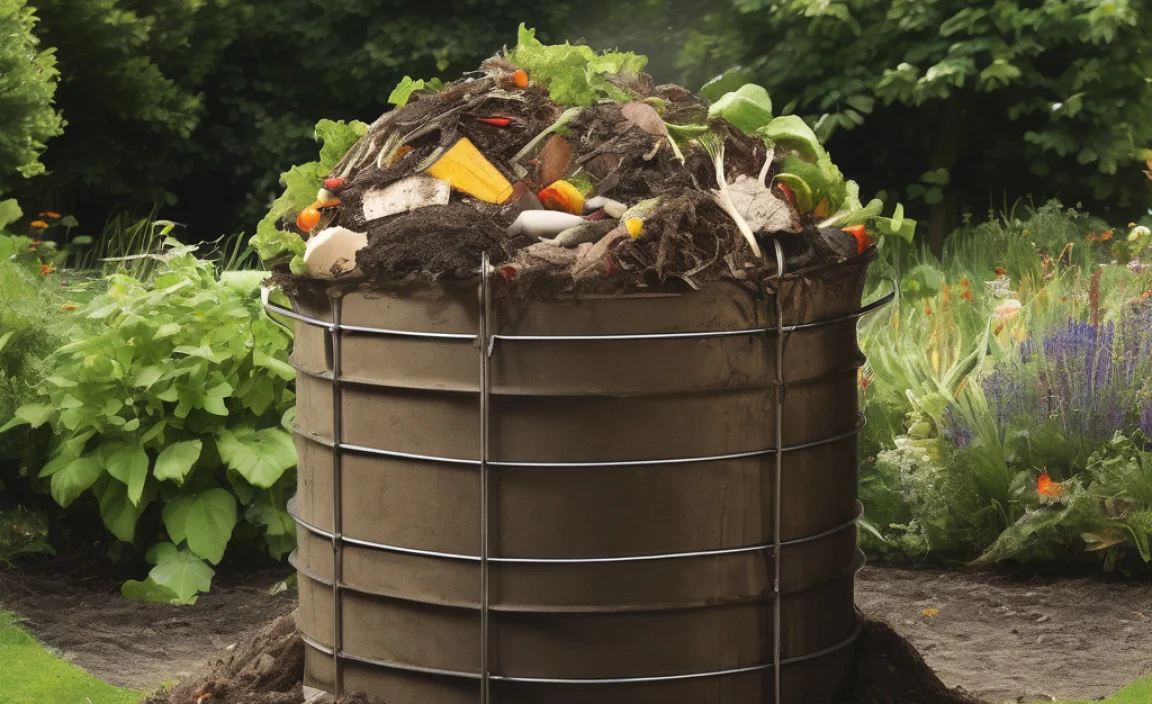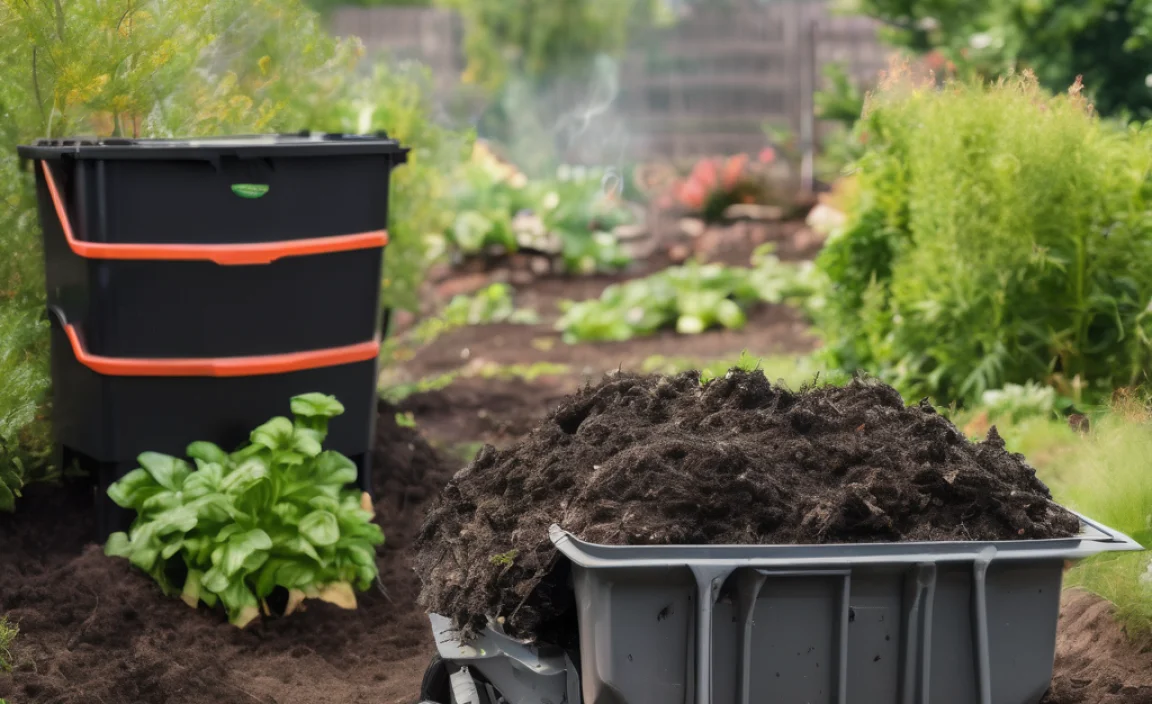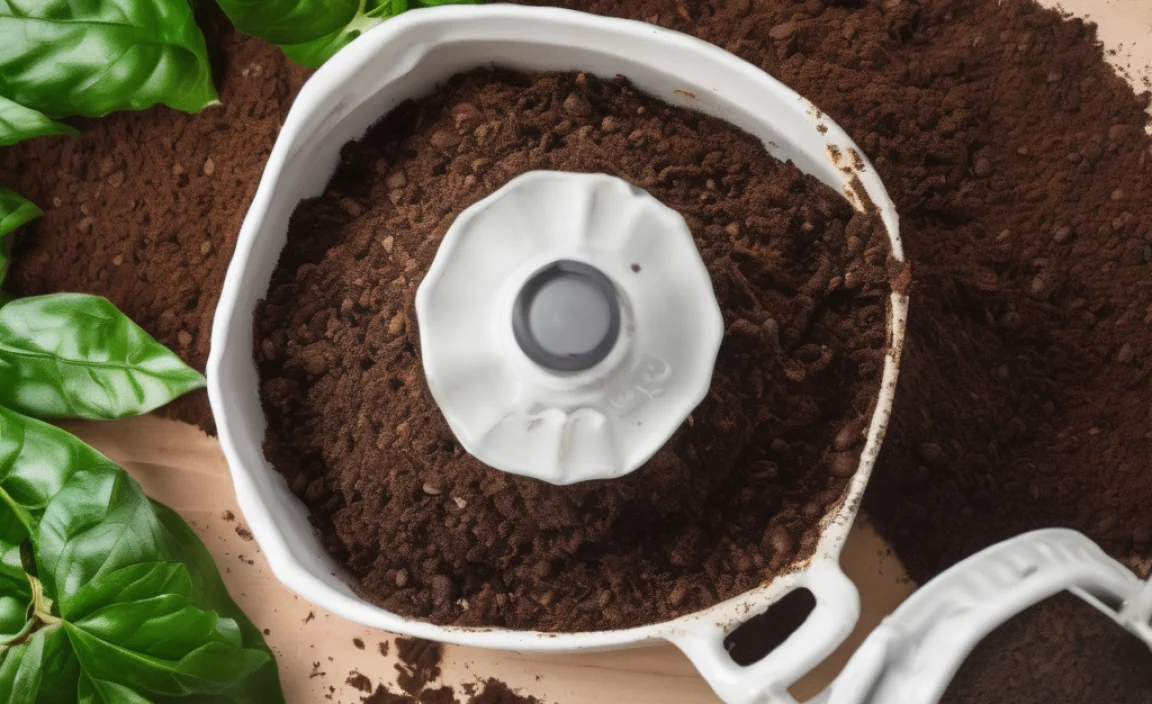Composting for Urban Areas: Tackling Common Challenges with Simple Solutions!
Living in the city doesn’t mean you can’t compost! Many folks think composting is just for sprawling backyards, but that’s not true. Even with limited space, you can turn kitchen scraps into garden gold. It feels great to reduce waste and feed your plants naturally. Let’s dive into the common hurdles urban composters face and how to easily overcome them.
We’ll cover everything from pesky critters to managing smells and finding the right bin. You’ll learn practical tips that make composting a breeze, no matter how small your living situation is. Get ready to transform your food waste into a valuable resource for your plants!
Why Compost in the City?
Composting is a fantastic way to shrink your garbage bins. It diverts food scraps and yard waste from landfills, where they would otherwise produce methane, a potent greenhouse gas. Plus, the finished compost is like a superfood for your plants. It improves soil structure, helps retain moisture, and provides essential nutrients, leading to healthier, happier gardens, balconies, or houseplants. It’s a win-win for your home and the environment.
Common Composting Problems in Urban Areas
Urban composting often comes with its unique set of challenges. Things can get a bit tricky when space, neighbors, and the natural environment interact differently than in a rural setting. Knowing these common issues beforehand can save you a lot of frustration and help you get started on the right foot.
Problem 1: Limited Space
This is usually the biggest hurdle for city dwellers. A traditional compost pile needs a fair bit of room, which isn’t always available in apartments, condos, or homes with small yards. The thought of a large, smelly bin might seem impossible.
Problem 2: Unpleasant Odors
No one wants their home or balcony to smell like rotting food. Improperly managed compost can indeed become smelly, especially in confined urban spaces where airflow might be limited. This can deter beginners and cause issues with neighbors.
Problem 3: Pests and Critters
Rodents like rats and mice, or insects like flies, can be attracted to compost bins, especially if they aren’t secured properly or if the wrong types of food scraps are added. This is a major concern for many urban residents.
Problem 4: Not Enough “Green” or “Brown” Materials
Composting works best with a balance of nitrogen-rich “green” materials (like fruit and vegetable scraps) and carbon-rich “brown” materials (like dry leaves or shredded paper). Urban dwellers might produce a lot of kitchen scraps but struggle to find enough brown materials.
Problem 5: Slow Decomposition
Without enough air, moisture, or the right balance of materials, compost can break down very slowly, or not at all. This can be discouraging for beginners who expect to see results relatively quickly.
Problem 6: Moisture Control
Compost needs to be moist, like a wrung-out sponge, but not soggy. Too much rain can make it waterlogged and smelly, while too little can slow down decomposition. Managing moisture can be tricky, especially in various weather conditions.
Problem 7: Neighbor Concerns
Even if your compost isn’t smelly or attracting pests, a neighbor might still object to it due to aesthetic concerns or fear of potential problems. Open communication and neat, contained composting systems can help mitigate this.
Essential Solutions for Urban Composting Success
Don’t let these challenges deter you! There are fantastic, practical solutions tailored for urban living. We’ll break down how to tackle each of these problems so you can enjoy the benefits of composting.
The key is choosing the right composting method and system for your specific space and needs. Many innovative solutions have been developed to make urban composting accessible and enjoyable for everyone.
Solution 1: Space-Saving Composting Systems
When space is tight, traditional piles are out. Luckily, there are several compact composting methods perfect for urban environments:
a) Tumbler Composter
These are enclosed barrels or bins that sit on stands. You add your materials, close the lid, and then ‘tumble’ them by rotating the drum. This aeration speeds up decomposition and keeps critters out. They are relatively tidy and can fit on a balcony or small patio.
Pros: Fast composting, pest-proof, easy to turn, contained.
Cons: Can be expensive, may require some effort to turn when full.
b) Worm Composting (Vermicomposting)
This is a top choice for small spaces like apartments or balconies. You use a special bin with red wiggler worms to break down your food scraps. Worm bins are compact, odorless when managed correctly, and produce nutrient-rich worm castings, which are excellent fertilizer.
Pros: Excellent for small spaces, odorless, produces high-quality fertilizer (worm castings), relatively low effort once set up.
Cons: Requires specific conditions (temperature, moisture), worms need care, cannot process large amounts of food waste or certain items (citrus, onions in large quantities).
For more on setting up a worm bin, check out this guide from the EPA on vermicomposting.
c) Bokashi Composting
This unique method uses fermentation rather than decomposition to break down food waste. It’s done in an airtight bucket with an inoculant (bran containing beneficial microbes). Bokashi can handle almost all food scraps, including meat and dairy, which are typically avoided in other composting methods. It’s fast and produces a nutrient-rich liquid and pre-compost material that can then be buried in soil or added sparingly to a traditional compost bin if you have one.
Pros: Processes all food waste (meat, dairy, oils), fast, compact, produces nutrient-rich liquid fertilizer, odorless.
Cons: Requires purchasing the bokashi bran and special bins, the end product is “pre-compost” and needs further decomposition in soil or a compost pile, can have a pickled smell when opened.
d) Small Bin Composting
Many commercially available compost bins are designed for smaller yards or patios. These are often enclosed, sometimes with aeration vents. They’re a good step up from a pile but more contained and aesthetically pleasing.
Pros: Compact, contained, can be relatively inexpensive.
Cons: Slower than tumblers, may require manual turning, can still attract pests if not managed well.
Solution 2: Managing Odors Effectively
A well-managed compost system should not smell bad. Here’s how to keep things fresh:
- Balance Greens and Browns: The primary cause of bad smells is an imbalance, often too many “green” (nitrogen-rich) materials. Aim for a ratio of roughly 2-3 parts browns to 1 part greens. Add more carbon-rich brown materials whenever you add kitchen scraps.
- Aerate Regularly: Compost needs oxygen for the aerobic bacteria that break down waste efficiently and without odor. If you have a tumbler, give it a turn every few days. For bins, use a compost aerator tool or a pitchfork to turn and mix the contents weekly.
- Bury Food Scraps: When adding kitchen scraps to an open or semi-open bin, bury them under a layer of brown materials. This helps prevent pests and reduces the chance of odors escaping.
- Maintain Proper Moisture: Compost should be damp like a wrung-out sponge. If it’s too wet, it will smell sour. If too dry, it will slow down. Add dry brown materials if wet, or water if too dry.
- Avoid Problematic Items: In most methods (except Bokashi), avoid adding meat, dairy products, oily foods, and diseased plants, as these can cause odors and attract pests.
For worm composting, ensure you’re not overloading the bin or adding too much citrus or onion family items. For Bokashi, the fermented smell is normal and not indicative of a problem.
Solution 3: Keeping Pests Away
Pests are a genuine concern, but easily preventable with the right setup and management:
- Use PEST-PROOF BINS: This is the most crucial step. Tumbler composters and Bokashi systems are fully enclosed. Worm bins, when properly sealed, also deter most pests.
- Secure Lids: If using a smaller bin, ensure the lid fits snugly and doesn’t have large gaps where pests can enter.
- Bury Fresh Scraps: As mentioned for odor control, always bury fresh kitchen scraps under a layer of browns in open or semi-open systems.
- Regular Turning: Aerating your compost makes it less appealing and harder for pests to establish themselves.
- Keep the Area Clean: Don’t leave compostable materials sitting around outside the bin. Clean up any spills immediately.
- Avoid Attractants: Never add meat, dairy, or oily foods to standard compost bins, as these are strong attractants for rodents and other scavengers.
If pests do appear, check your bin’s integrity. Sometimes, introducing a layer of dry leaves or straw on top can deter them.
Solution 4: Balancing Your Greens and Browns
This is fundamental to successful composting. Many urban dwellers have an abundance of “greens” (kitchen scraps, coffee grounds, tea bags) and a shortage of “browns” (carbon-rich materials).
Where to Find Browns in the City:
- Shredded Paper and Cardboard: Newspaper (avoid glossy inserts), plain brown paper bags, toilet paper tubes, egg cartons, and plain cardboard boxes. Shred them to improve decomposition.
- Dry Leaves: Collect them in the fall if you have access to any trees, or ask neighbors if they’re bagging theirs up. Store them in a dry place.
- Sawdust: If you or a neighbor does woodworking using untreated wood, sawdust is a great carbon source.
- Straw: Available at pet stores or garden centers, straw is a good option.
- Coconut Coir: A sustainable option, often used in potting mixes.
- Yard Trimmings (if available): Small amounts of dry grass clippings or small twigs.
The Ideal Mix: Aim for roughly 2-3 parts browns to 1 part greens. If your compost looks wet and smells ammonia-like, you need more browns. If it’s dry and not breaking down, you might need more greens or moisture.
Consider gathering a stockpile of brown materials to have on hand. Keeping a bag of shredded newspaper or torn-up cardboard near your compost bin is a simple hack.
Solution 5: Speeding Up Decomposition
Slow composting can be a bummer, but here are ways to speed it up:
- Chop Materials Smaller: The smaller the pieces, the more surface area the microbes have to work on. Chop up large fruit rinds, vegetable stalks, and cardboard.
- Aerate, Aerate, Aerate!: Regular turning or tumbling introduces oxygen, which is vital for the microorganisms doing the work.
- Maintain Optimal Moisture: Compost should be as damp as a wrung-out sponge. If it dries out, decomposition slows dramatically. If it’s too wet, it can go anaerobic and smell.
- Add “Activators”: While not always necessary, you can add finished compost, or even a bit of garden soil, to introduce beneficial microbes. For Bokashi, the inoculant is essential. For worm bins, the worms themselves are the “activators.”
- Consider a Thermophilic (Hot) Compost System: If you have a bit more space and are committed, hot composting can break down materials in a few weeks. This requires a larger bin (at least 3 cubic feet) and careful management of greens, browns, moisture, and aeration. Tumblers can sometimes reach hot composting temperatures if managed well.
For a quick overview of composting basics, the Royal Horticultural Society offers excellent, in-depth guides.
Solution 6: Controlling Moisture Levels
Moisture is key. Your compost should feel like a damp sponge – moist but not dripping when squeezed.
- Too Wet? Add Dry Browns: If your compost feels soggy and smells sour, you’ve got too much moisture, likely from too many “greens” or excessive rain. Mix in a generous amount of dry brown materials (shredded paper, cardboard, dry leaves) to soak up excess water and improve aeration.
- Too Dry? Add Water: If your compost seems dry and is not breaking down, decomposition will halt. Lightly water the pile, ideally while turning it, to distribute moisture evenly. Aim for that “wrung-out sponge” consistency.
- Covering: In very rainy climates, consider covering your compost bin with a tarp or lid to prevent it from getting waterlogged. In dry climates, a lid can help retain moisture.
Solution 7: Keeping the Peace with Neighbors
Open communication and a well-maintained compost system can go a long way:
- Choose an Odor- and Pest-Proof System: As discussed, tumblers, Bokashi, and sealed worm bins are the best choices to prevent any nuisance.
- Keep it Tidy: Ensure your composting setup looks neat and organized. Avoid clutter around the bin.
- Talk to Your Neighbors: If you have a friendly relationship, let them know what you’re doing. Explain the benefits and how you plan to manage it cleanly. Offering them some finished compost can be a nice gesture!
- Start Small: Begin with a compact system like a worm bin. Once you’re successful and confident, you can expand your efforts if needed.
- Educate Yourself and Them: Share information about how composting is safe and beneficial, not a source of pests or smells when done correctly.
Choosing the Right Urban Composting Method: A Quick Comparison
Let’s put some of the main urban composting methods side-by-side to help you decide.
| Feature | Tumbler Composter | Worm Composting (Vermicomposting) | Bokashi Composting | Small Bin Composter |
|---|---|---|---|---|
| Space Required | Small patio/balcony | Very small (indoor/outdoor) | Very small (kitchen counter/balcony) | Small patio/balcony |
| Speed of Processing | Fast (weeks to a few months) | Moderate (worms process steadily) | Fast (initial pickling ~2-3 weeks, then needs burying) | Moderate (months) |
| Types of Food Scraps | Veg/fruit scraps, coffee, tea, yard waste, grain | Veg/fruit scraps (limited citrus/onion), coffee, tea, paper | All food scraps (incl. meat, dairy, oils) | Veg/fruit scraps, coffee, tea, yard waste, grain |
| Odor Potential | Low (if managed well) | Very low (if managed well) | Slightly fermented/pickled smell when opened, otherwise odorless during processing | Low to moderate (if managed well) |
| Pest Resistance | High (enclosed design) | High (with proper lid seal) | High (airtight system) | Moderate (depends on bin design and sealing) |
| Cost | Moderate to High | Low to Moderate | Low to Moderate (initial bin purchase) | Low to Moderate |
| End Product | Compost | Worm castings & compost tea | “Pre-compost” & nutrient liquid | Compost |
Getting Started with Your First Urban Compost!
Ready to start? Here are the basic steps, regardless of the system you choose:
- Choose your System: Based on your space, budget, and what you want to compost, select a tumbler, worm bin, Bokashi, or small bin.
- Gather your Materials: Get your chosen bin

I am passionate about home engineering. I specialize in designing, installing, and maintaining heating, ventilation, and air conditioning systems. My goal is to help people stay comfortable in their homes all year long.




